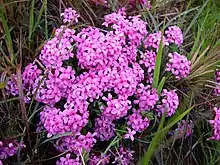| Daphne cneorum | |
|---|---|
 | |
| Scientific classification | |
| Kingdom: | Plantae |
| Clade: | Tracheophytes |
| Clade: | Angiosperms |
| Clade: | Eudicots |
| Clade: | Rosids |
| Order: | Malvales |
| Family: | Thymelaeaceae |
| Genus: | Daphne |
| Species: | D. cneorum |
| Binomial name | |
| Daphne cneorum | |
| Synonyms[1] | |
| |
Daphne cneorum, the garland flower or rose daphne, is a species of flowering plant in the family Thymelaeaceae, commonly found in various pine forests across Europe.[2][3] It is a prostrate spreading evergreen shrub to 20 cm (8 in), grown for its dense clusters of highly fragrant pink flowers in spring.[4][5][6] All parts of the plant are poisonous to humans.[7] Two common diseases are known as daphne sudden death syndrome and daphne virus X.[2][8][9]
The Latin specific epithet cneorum comes from Greek origins and means “like a small olive bush”.[10]
.JPG.webp)
Habitat
In the Boreal age, Daphne cneorum was predominantly found in pine forests, alongside other species such as Galium boreale and Rubus saxatilis.[11] In more recent ages, this species is native to the mountains of central and southern Europe, including an area known as the Châtillonnais region and several parts of Ukraine.[11][3] Within these regions, Daphne cneorum is commonly found in pine forest, oak-pine forest, and beech-pine forest habitats.[3] Other species found in these habitats include Vaccinium myrtillus, Lycopodium annotinum, Pteridium aquilinum, Maianthemum bifolium and Trientalis europaea.[3] Daphne cneorum is typically found in well-lit patches of rocky soil, the foundation of which is generally carbonate rock.[12][3]
Diseases
In plant nurseries rose daphnes can be affected by various diseases. One of them is caused by the fungus Thielaviopsis basicola and is commonly known as daphne sudden death syndrome (DSDS).[2] In this disease, dark colored lesions grow along the roots, soon followed by discoloration of leaves, stunted growth, fainting, and then in the two weeks after developing foliar symptoms, death.[8][2]
One of the more common viruses affecting daphne cneorum, and other species of the genus daphne, is daphne virus X.[9] It was discovered that in-vitro daphne cneorum cultures can be used as a growing medium to detect if other plants are infected with the disease.[9] This allows for faster identification of diseased plants, thus allowing for prevention of the spread to other plants within nurseries, gardens, etc.[9]
References
- 1 2 "Daphne cneorum". The Plant List. Retrieved 2017-11-17.
- 1 2 3 4 Noshad, David; Riseman, Andrew; Punja, Zamir (2007). "Evaluation of Daphne Germplasm for Resistance to Daphne Sudden Death Syndrome Caused by the Soil-borne Pathogen Thielaviopsis basicola". American Society for Horticultural Science. 42 (7): 1639–1643 – via American Society for Horticultural Science.
- 1 2 3 4 5 Melnik, Victor (1996). "Distribution and plant communities of Daphne cneorum and Daphne Sophia in Ukraine" (PDF). Thaiszia Journal of Botany. 6: 49–66 – via Univerzita Pavla Jozefa Šafárika V Košiciach.
- ↑ "Daphne cneorum". University of Delaware Botanic Gardens. Archived from the original on 28 September 2011. Retrieved 26 May 2011.
- ↑ "Rose Daphne". Winnipeg, Manitoba: Shelmerdine Garden Center. Archived from the original on 26 August 2011. Retrieved 26 May 2011.
- ↑ RHS A-Z encyclopedia of garden plants. United Kingdom: Dorling Kindersley. 2008. p. 1136. ISBN 978-1405332965.
- ↑ "Daphne cneorum". RHS. Retrieved 7 May 2019.
- 1 2 Noshad, D.; Riseman, A.; Punja, Z. K. (June 2006). "First report of Thielaviopsis basicol a on Daphne cneorum". Canadian Journal of Plant Pathology. 28 (2): 310–312. doi:10.1080/07060660609507300. eISSN 1715-2992. ISSN 0706-0661.
- 1 2 3 4 Wei, C; Green, M.J.; Godkin, S.E.; Monette, P.L. (1 September 1992). "Use of in vitro Cultures of Daphne cneorum L. for the Western Detection of Daphne Virus X." Journal of Enviornmental Horticulture. 10 (3): 153–156 – via Horticultural Research Institute.
- ↑ Harrison, Lorraine (2012). RHS Latin for Gardeners. United Kingdom: Mitchell Beazley. ISBN 978-1845337315.
- 1 2 Muller, Serge (March 1977). "The Post-Glacial History of Pulsatilla vernalis and Daphne cneorum in Bitcherland, Inferred from the Phytosociological Study of Their Current Habitat". Global Ecology and Biogeography Letters. 6 (2): 129–137 – via JSTOR.
- ↑ Dakskobler, Igor; Seliškar, Andrej; Vreš, Branko (2011). "Daphne alpina L. subsp. scopoliana Urbani × Daphne cneorum L. subsp. cneorum = Daphne ×savensis nothosp. nov., a new spontaneous hybrid in the genus Daphne L." Wulfenia. 18: 1–14 – via ResearchGate.